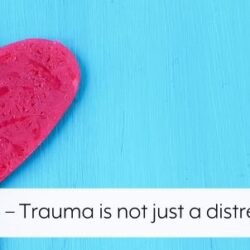
‘I don’t know if I’ll able to be able to recover,’ he said, suddenly vulnerable. ‘I can’t seem to shake off this trauma. I can’t get over it, no matter how hard I try.’
Perhaps he thought I was going to object, or reason him out of it. Tell him it would be fine, and just be positive. But I got it. Of course. Most of my life I’ve been at where he’s at. However much progress I make, it’s always that nagging doubt still in my head: Is this as good as it gets? What is wrong with me that I can’t recover ‘more’? What is wrong with me that recovery from trauma is so hard in the first place?
I met his gaze, and replied slowly, ‘If trauma were easy to heal, we’d all be healed by now.’
We don’t fail to heal from trauma quickly because there’s something wrong with us – because we’re stupid, because we enjoy being victims, because we’re mentally ill, because we’re lazy, because we’re weak. Trauma is difficult to heal from. It’s meant to be. Trauma is the way that our brains and bodies adapt to an experience or environment of life-threatening powerlessness: to situations of overwhelm that are extremely dangerous to our survival. If our brains and bodies don’t take that seriously, we won’t stay alive. We’re supposed to ‘over-react’ to life threat. We’re supposed to try to ensure that it never happens again. The symptoms of trauma are the outward manifestation of our bodies and brains trying to do just that – avoidance (our primary defence), hypervigilance (let’s be on the lookout), flashbacks (reminders and warnings), hyperarousal (let’s be ready to run or fight). Our brains and bodies are just trying to keep us safe.
So trauma isn’t meant to be easy to recover from, because better a traumatised brain than a dead one. And implicit to the nature of being traumatised are its paradoxical challenges: what we need to recover from trauma are the exact same things that trauma suppresses in our lives. That’s a double-bind, but one that definitely isn’t our fault. (Cut yourself some slack, anyone?)
-
Trauma takes our front brain offline – but our front brain is essential for healing.
There are lots of ways of looking at and thinking about the brain, many of them so complex that you literally need to be a brain scientist to understand them. I prefer a simpler, more add-water-and-stir approach – one that is immediately useful. And so I split the brain into two parts: front and back. This is more about its functions in relation to trauma than its pure anatomy – more metaphor than map – but I’ve personally found it consistently, simply, helpful.
Our back brain is all the primitive stuff, the functions that keep us alive, the things we do unconsciously, everything that is based in survival and automaticity. And then our front brain is our conscious, thinking, reflecting, planning, strategising, superbly clever human brain. During trauma, our front brain, in broad terms, switches off, and our back brain takes over. In being traumatised, we are dominated and at times even hijacked by our back brain, which orients towards danger and reverts us to habits of safety-seeking and assuming the worst.
In healing from trauma, we need to build up and support the front brain in taking back control: making choices, rather than reacting instinctively; assessing for danger thoughtfully and with nuance, rather than jumping to conclusions; considering and applying new information, rather than relying on what’s always happened to us in the past. We need our front brain to strategise our way out of all the external hindrances to recovery: poverty, homelessness, unemployment, relational problems, lack of treatment options, and the myriad of challenges that come with trauma, including dissociation, that quintessentially back-brain state.
If for example we need therapy but can’t afford it, we need our front brain fully engaged to figure out a plan – seeing all the options immediately visible and all of the ones that are yet invisible; engaging trial and error and learning from it; being persistent in sticking to the plan and not giving up; finding ways to elicit support from others; carefully assessing and analysing the suitability of prospective therapists to work with. It’s a complex challenge. It requires a complex brain.
Our back brains will sink into the default of red zone ‘I can’t’ and give up because they have been conditioned by trauma to freeze, to not try anything – because, in trauma, resistance is futile and we carry that sense of immobilisation into everything we do (or rather don’t do) in the future. It’s the front brain that – via that most frontal of front brain activities, imagination – dreams up the possibilities for how we can recover and live a life different to the one that has gone before. The back brain ‘knows’, in all its black-and-white certainty, that life in the future will be a mirror of life in the past, and so ‘knows’ that there’s no point seeking an alternative route. The front brain could navigate us past these blockages, but the back brain says ‘no’, to try keep us safe, to avoid disappointment and hurt and – above all else – to prevent the trauma ever happening again: better safe than sorry. Better do nothing and fail than try anything different and fail bigger.
So it’s the front brain we need online to integrate our experiences, to strategise towards a better future, to engage help and support and even treatment. But trauma reverts us to our back brains and keeps us firmly stuck there. The very tool we need to get ourselves out of trauma – our neocortex, and specifically our frontal lobes – is shut down by trauma itself. Catch-22.
-
Trauma makes us wary of people, but our neurobiology needs people to feel safe.
In attachment theory, there’s a seminal research protocol called ‘The Strange Situation’. A one-year-old plays in a room with toys with their primary caregiver, and then on two separate occasions the caregiver departs, leaving the infant on one occasion alone and on another with just the stranger. How will the child react? Not just to the separation, but to the reunion? This simple two-minute procedure is the bedrock of attachment theory. One of its most striking findings was that when a child has a caregiver who is either ‘frightened or frightening’, they simply don’t know what to do upon reunion. Do they approach the caregiver for comfort (are they safe?), or do they avoid them (are they dangerous?) That conflict plays out graphically during the Strange Situation: some children fall to the ground and lay paralysed, in a dissociative state, overwhelmed and shutdown. Some move towards their caregiver, but backwards. It’s the paradox of conflict between approach and avoid that has come to be known as ‘disorganised attachment’: there’s no ‘organised’, effective strategy to feeling safe with an unsafe caregiver – it’s ‘fear without solution’.
And this is what we see in trauma, especially when the event or environment which caused life-threatening powerless has been perpetrated by people. When we’ve been abused or neglected, when it’s people who have caused the trauma, then we’re stuck in a dilemma. We need the help of people to heal, but it’s people who caused the problem. Our back brains scream at us to be wary, to keep our distance, to shield ourselves and especially our vulnerabilities. And then healing is offered in the shape of a therapist sat a few feet away, come to prod into our most sacred, broken places. What we most need is then what we most fear.
And shame, too, consumes us: the desperate, clawing need to distance ourselves from the people most likely to reject us, humiliate us, belittle us or hurt us. Why would I give ammunition to a therapist for him or her to shoot back at me? It was people who hurt me, and now to heal from that hurt, to overcome that mistrust, I need to trust? It’s a bewildering paradox, a chicken and egg situation that cannot be resolved without brave front-brain interventions, because shame (another quintessentially back brain state) insists that I stay hidden and distant.
-
We need to be able to manage our distress, but in childhood we were not taught how.
Trauma is distressing. We may not always feel that distress – either at the time or afterwards – because sometimes it’s simply not adaptive to do so, so at a preconscious level feelings are dissociated. Instead often that distress manifests in behaviours or physical illness – albeit that insight too often eludes us. But fundamentally trauma can be nothing other than distressing: of course, when bad stuff happens, we react, even if unconsciously, with aversion and with the instinct to change the situation. Emotional distress is the correlate to that cry within us of, ’Get me out of here!’ It feels so awful to feel distressed because it’s meant to: it’s trying to get us to do something to change the situation.
Distress is meant to be felt. But when trauma stops us feeling, when our emotions are ‘dissociated’, it doesn’t mean that they don’t exist. They just seep out in other ways. But sometimes we do feel them – big, crashing waves of them, and they become overwhelming. One of the most striking symptoms of trauma is ‘dysregulation’: being upset both in our feelings and in our bodies, unable to calm down, unable to settle. It’s the urgent need to feel differently but being stuck a long way from the calm and safety and ‘ohm’ of the green zone.
From infancy the key way we regulate our emotions is via other people: the mother, the father, the primary caregiver. Soothing comes from physical touch, eye contact, motion, the soft and gentle nurturing care that whispers quietly that all will be well, that there may be all manner of sensation – hungry, wet, tired, lonely, scared – but I’m here now and all will be well.
For an adult to regulate an infant, they need to be regulated themselves. They need to be calm to calm the child. This is a fundamental way in which trauma passes from generation to generation, by the traumatised parent unable to regulate themselves and so unable to regulate their child. Even with no malicious intent, a consistently dysregulated parent can become the frightened and hence frightening caregiver, setting the child up for trauma.
But by soothing the baby, the baby’s brain builds networks, little pathways and roads over which calming chemicals can flow. And even with a good enough parent, if we are subject to frequent trauma via others, that overwhelm of fear and threat and sensation, like a storm, disrupts the building of the transport network. Into adulthood, when the brain infrastructure should be in place, instead it’s littered with traffic cones and contraflows, with potholes and dead ends. Soothing is possible, but sometimes only just, and sometimes only after long, persistent journeys, from finding alternative pathways, or with the assistance of external chemicals.
And then comes distress in the here-and-now: the big explosion of upset from a trigger, a flashback, a relational bust-up, a sudden shock, more trauma. We want an ambulance, but there are no roads for it to drive on. In order to recover from trauma, we need soothing, reassurance, calming, interactive regulation with a safe ‘other’. Not only are we as trauma survivors more likely to be alone during times of distress, lacking basic social support, but our brain also triggers in response to the memory of dangerous humans who are now come close to help (or harm?) us. And the soothing chemicals that their regulation releases into our brains gets gnarled up like traffic in our brain. If we hadn’t been traumatised, we would be so much better equipped to recover from trauma.
These are just three of the challenges of trauma, the paradox of needing the very things that trauma robs us of. This is why trauma is hard (although not impossible) to recover from. It’s not a problem in us. It’s a problem in the very nature of the adaptations that trauma wreaks in our neurobiology.
There are of course ways around all of these issues: we need to build front brain capacity whenever we are calm, not just when we need it; we need to be curiously open to the possibility that not everyone is out to hurt us; and we need to focus on developing the skills of affect regulation. But it’s not a case of ‘three easy steps and you’re done’. These are overarching principles, not goals to be completed by Friday.
Trauma is a neurobiological state where our brains are preconsciously focused on survival, threat and danger and are relatively closed to forward motion, new learning, and risk-taking. There are many things which keep us stuck in it. One of the greatest, however, is beating ourselves up. If we understand trauma as a state where we feel in danger, it makes sense that attacking ourselves simply heightens that sense of risk. It further shuts down our front brain and raises the state of alarm. It is the most pernicious of vicious cycles.
I have frequently said that trauma recovery is like being asked to climb a flight of stairs so that you can attend a paralysis clinic. If we could at least understand the inherent paradoxes in trauma, we could perhaps extend towards ourselves a little more patience. There are ways to resolve trauma, but our starting point is showing ourselves a touch more self-compassion that we find it so hard in the first place. We don’t get over trauma by choosing to. We can’t just ‘put it behind’ us. Trauma is intransigent because it’s trying to keep us safe. Its motto is ‘survive, not thrive’. Understanding that is the first step towards not blaming ourselves for how difficult it is – because the self-blame and the shame that come as free bonus features with trauma will keep us stuck forever.



27 Comments
Thank you so much for your beautifully written, really clear and supportive explanations. Am often recommending your work. All the very best,
Danièle W
Systemic Family Psychotherapist
EMDR practitioner
Beautifully articulated.
That is one of the best explanations of trauma and recovery that I have read Carolyn. And it popped into my inbox at exactly the moment when I needed it this morning. Thank you so much for all the work you do.
Thank you for this article. My counselor recommended it and sent me a link. I qpprecite now.
Thank you Carolyn. Your blogs are always extremely helpful and thought-provoking, and help me to work (hopefully) safely for my traumatised clients. Your generosity in sharing your knowledge in this way is admirable.
Thank you so much.
Sue
As ever, Carolyn describes the topic in plain, down-to-earth, language. She has a great gift for presenting things in a concise way and her metaphor and simile make things incredibly accessible.
I’m a counsellor and have a reasonable grasp of the subject of Trauma, yet I still find her blogs, training courses and other literature the best source for my own understanding and as a psycho-educational resource for my clients. Long may you continue Carolyn!
This is a great article. Having been in recovery for 30 years or more I often reach a point of feeling ‘ is this it? Is this what I’ve worked for?’ It can be so hard sometimes to not find a pot of gold at the end of the rainbow, rather a continuing journey that can be so tiring
An excellent and easy to understand explanation, thank you very much.
I think this is an excellent piece of writing.
I am a newly qualified hypnotherapist and this topic is covered in layman’s terms, enabling me to fully engage and understand better than ever before.
Thank you so much for this.
Thank you for this.
I really need some of the complexity of trauma recovery explained and simplified and this has helped hugely.
Just what I needed today all so sensible and down to earth my day will be better having read this today
Thank you so much
B
Carolyn it’s so good to hear from you again. Your timing is just amazing since I’ve just started counselling again after a break (not of my choosing). I am genuinely grateful and delighted with this opportunity to start again but also the gremlins are saying ‘are you still trying to do this?, do you really think you can get any better?’ etc.
Yes, I’ve already got so much better a life and I know there’s still more healing I can achieve. Yes, it will take time and it will be difficult. But, yes, I am a survivor and a fighter and I will never give up because what else would I do and I deserve the best life I can give myself.
Thanks Carolyn and all the best
Thank you Carolyn . . . . .my mind so appreciates your clarity and simplicity . . . . . . .and my body knows you know, it knows you have been there . . . . .. .so your words reach deep, and so greatly support my healing.
Thank you, as ever, for the clarity of your writing about trauma, which makes it a bit more navigable for me as a counsellor. I often reccommend your website to clients. Would it be ok to make a direct link to this particular article from my own website? It feels like an excellent place to start for anyone who is trying to get a handle on their experience of trauma.
Thank you for your empowering and articulate words. I work with trauma constantly and I find your explanations of the complexities of the long term residual effects of it are so helpful and motivational for making positive change both for my client work and also my own,sometimes, ‘uphill climb’.
Linda
This description and explanation is so very good, Carolyn. It allows me as trauma survivor to breathe a little deeper. In my role as psychotherapist, it gives me a tool for psycho-education for example. I must say, self-compassion is stimulated through the very way you describe the dilemma. A heartfelt thank you.
Thank you Carolyn!I needed to read this tonight and be reminded I am not alone. I can do this! I am doing this! Better together! Bless you!
This helps explain trauma and how the brain reacts to it in such a succinct way.
I really like the link to early attachment. Thank you.
As a foster carer of 8 years, this rings so many bells when considering the young people who have been in our care. Supporting them in a therapeutic way is always a challenge because we rarely know for certain the root causes of their trauma.
This approach is helpful because really, the cause of the trauma is not as important as how to help the young people learn the skills of dealing with their own trauma. To help them shift their fight or flight response into an understanding of what is happening to them. This does gradually help them to use their “Front Brain” as well as their defence mechanisms.
Thank you for a lucid presentation of what is going on in those young brains.
Another superbly written article, sharing the insight of not only one who is learned, but one who has personal experience. So, if there is a silver cloud in any of our sufferings, it is in the deep knowing, the deep feeling, the deep insight as to what ‘the other’ is going through too. That, in my work as a therapist, is a gift that cannot be learned. Experience of our suffering makes us the people we are, with all our flaws certainly, but with the gift of giving to another the very real notion that we ‘get it’. You’re an inspiration Carolyn.
[…] https://www.carolynspring.com/blog/three-challenges-of-trauma-why-recovery-is-so-hard/ […]
Once again Carolyn, a great blog, easy to read and understand – love the humour too, as this is such a difficult topic to deal with in the counselling room. I am always reciting your words and referring clients to your work. Thank you.
May I add another paradox and complexity in the case of DID/profound structural dissociation: that when our brains have exploded into fragmented ‘identities’ in order to survive, it is not enough merely to be able to access the front brain in some of those identities if we are still split off from other identities which hold memory, emotion and other aspects of trauma without front brain access. Integration of identities is (in my personal view) necessary to enable simultaneous front and back brain activation, so that ‘everyone inside’ can come to be in the present, grounded and aware of being safe. With front brain access only in some identities, my experience is that the symptoms just continue. This yet again the process our brains used to survive (the splitting into ‘different people’) is the very element that blocks healing.
This makes so much sense to me, it explains why I’m like I am and particularly why I’ve found therapy so difficult. It almost felt like being traumatised but for the exact opposite reasons of the original cause. My challenge is to keep moving towards acceptable level of recovery.
Thank you for the comments. The comments actually help me further understand and integrate the material. What a superb teaching tool/experience. I am so grateful I found this teacher. (Survivor, therapist of 30 years, just discovered undiagnosed autism and dissociative identity. Maybe when I come out of shock, I can think about what to do next. In the meantime I keep working, because that’s when I am not a failure, for the most part.)
This has been very helpful.. easy to read and understand – Thank you for sharing this!
Your blog and podcast have been a life saver for me. I found it about a year ago. Thank you for sharing yourself and your story!